Batch cooking in sun ovens works best when you combine several key factors. You'll need clear skies and strong sunlight between 11 AM and 3 PM, with peak temperatures reaching 250°F-350°F. Dark, metal containers and proper insulation help maintain consistent heat, while stacking pots vertically maximizes space. It's crucial to preheat your oven for an hour and refocus it every 30 minutes. Start with quick-cooking items like breads in mid-morning, then move to main dishes at solar noon, finishing with slow-cooking stews later. Mastering these elements will reveal your sun oven's full batch-cooking potential.
Perfect Weather For Solar Cooking
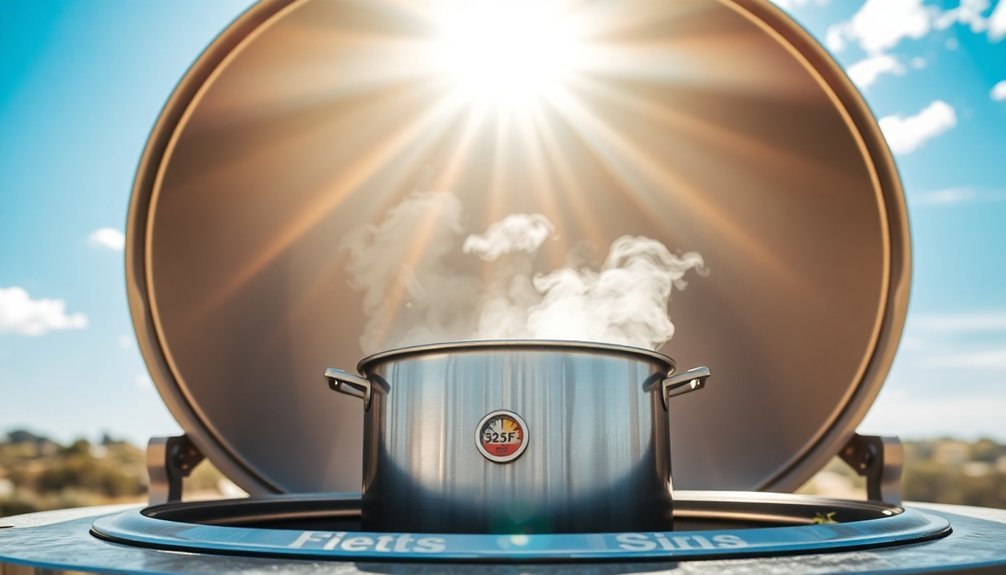
While solar cooking can be done in various conditions, understanding the perfect timing and weather is essential for success.
You'll achieve the best results between 11:00 am and 3:00 pm when the sun is directly overhead and UV rays are strongest. During these peak hours, your solar oven will reach ideal cooking temperatures.
You'll want to choose a clear, sunny day and find a sheltered spot to protect your oven from strong winds. A day with 30-45 minutes of sunlight per hour is sufficient for effective solar cooking.
While you can solar cook year-round, fall and winter present more challenges due to the sun's lower position and less intense rays. If you live in areas like Southern Arizona or Texas, you'll have more opportunities for solar cooking than in cloudy regions like Oregon or Washington.
Timing Your Batch Meals Right
Now that you understand the ideal conditions for solar cooking, mastering the timing of batch meals will maximize your sun oven's potential. You'll need to plan your cooking sequence carefully, considering that temperatures typically range from 250°F to 350°F depending on weather conditions. Using blue enamel cookware helps achieve more consistent heating across multiple dishes.
| Time of Day | Cooking Strategy |
|---|---|
| Early Morning | Preheat oven for 1 hour |
| Mid-Morning | Start first batch of breads/muffins |
| Solar Noon | Cook main dishes at peak heat |
| Early Afternoon | Prepare soups or stews |
| Late Afternoon | Finish with slow-cooking items |
Remember to refocus your oven every 25-30 minutes and minimize door openings, as each peek adds 10-15 minutes to cooking time. For efficient batch cooking, use stackable containers and guarantee proper airflow between items. You'll achieve the best results by stirring liquids and rotating solid foods every 10-15 minutes.
Essential Solar Oven Equipment
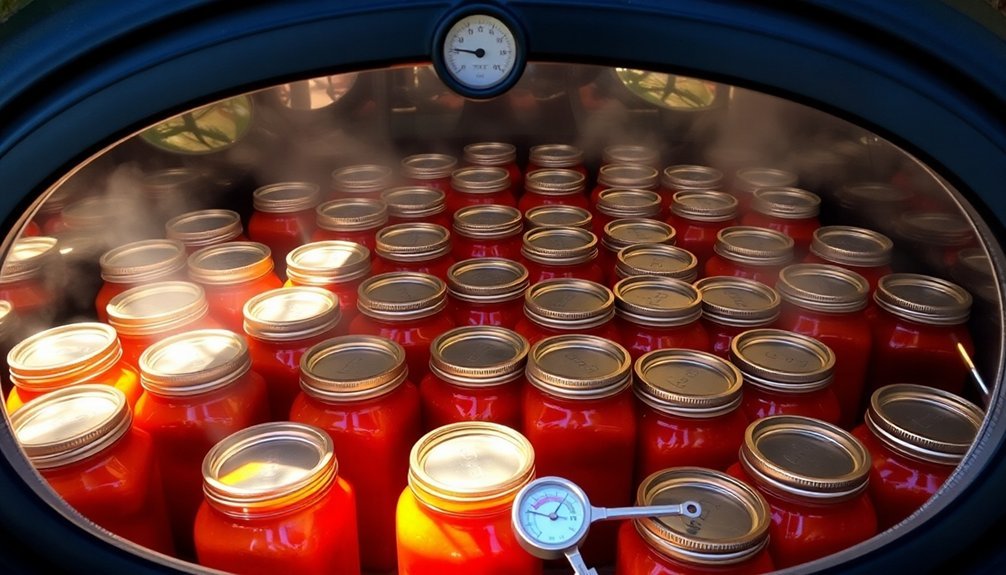
For successful batch cooking in your sun oven, you'll need dark-colored containers that effectively absorb and retain heat.
Line your containers with aluminum foil to enhance heat reflection and distribution throughout your food. Your containers should be made of materials like cast iron, dark metal, or black enamel cookware to maximize heat absorption and cooking efficiency.
A good thermometer helps you track the internal temperature, ensuring your food reaches safe cooking temperatures between 200-300°F (93-149°C).
Dark Containers Maximize Heat
To maximize your solar oven's efficiency, dark-colored containers serve as the cornerstone of successful cooking by absorbing all wavelengths of light and converting them into usable heat.
Think of these containers like a car's dark interior on a sunny day – they capture and retain heat effectively, making them perfect for solar cooking. Including R50 insulation values around your containers helps maintain optimal cooking temperatures.
For ideal heat absorption and retention, you'll want to:
- Choose thin, shallow metal containers with dark surfaces and well-fitting lids
- Pair your dark containers with transparent glazing like oven bags or glass covers to trap heat inside
- Position reflective materials around your container to concentrate more sunlight onto the cooking surface
These container characteristics work together with your solar oven's design to maintain consistent temperatures, ensuring your batch meals cook thoroughly and efficiently.
Optimal Temperature Tools
Successful solar cooking relies on three essential temperature tools: accurate thermometers, reflective surfaces, and proper insulation.
You'll need thermometers to monitor internal temperatures, which can range from 200°F in simple designs to 550°F in advanced models.
To maximize heat, you'll want to use aluminum foil or specialized reflective materials positioned at ideal angles. These surfaces concentrate sunlight and boost your oven's temperature. The GoSun Sport Solar Cooker's parabolic reflectors demonstrate how effective this can be.
Don't forget about insulation – it's vital for maintaining consistent heat. You can use polystyrene, newspapers, or vacuum tubes to prevent heat loss.
Make sure your oven has airtight seals and a black heat-absorbing surface at the bottom. Remember to adjust your oven's position throughout the day to maintain ideal sun exposure.
Best Foods For Solar Batching
Your sun oven's batch cooking success starts with choosing dark-colored pots and pans that efficiently absorb solar energy.
You'll get the best results when cooking moisture-rich foods like stews, soups, and braised meats that won't dry out during long cooking times.
When you combine dark cookware with liquid-based recipes, you're creating ideal conditions for consistent, even heating throughout your solar cooking session.
Dark Containers Work Best
When cooking with a sun oven, dark-colored containers play an essential role in maximizing heat absorption and efficiency. Dark surfaces convert sunlight into heat energy more effectively than light ones, ensuring your food cooks thoroughly and evenly.
You'll get the best results using thin, dark metal pots with tight-fitting lids, though glass or ceramic containers can work too.
For ideal solar cooking results, remember these key points:
- Choose dark, shallow pots that can conduct and retain heat well
- Cut food into smaller pieces to reduce cooking time
- Expect cooking times between 1-8 hours for 4 pounds of food
You can prepare a variety of dishes in your dark containers, from solar lasagne to tandoori chicken.
The versatility of dark cookware makes it perfect for both liquid and solid meals in your sun oven.
Moisture-Rich Foods Excel
Solar ovens excel at preparing moisture-rich foods, making them perfect for batch cooking stews, soups, and legume-based dishes.
You'll find that moisture stays trapped inside, ensuring your meals remain tender and flavorful throughout the cooking process.
Foods like lentils, peas, and beans are ideal choices since they benefit from slow cooking and natural moisture retention.
You can also prepare grains such as rice and noodles effectively, as they'll absorb liquid consistently in the contained environment.
When you're cooking vegetables like summer squash and green beans, they'll maintain their moisture and cook relatively quickly.
To optimize your results, reduce liquids by 1/4 to 1/2 cup since there's minimal evaporation.
You'll also want to leave a small airspace when covering your pot to allow some hot air and excess moisture to escape.
Temperature Control And Management
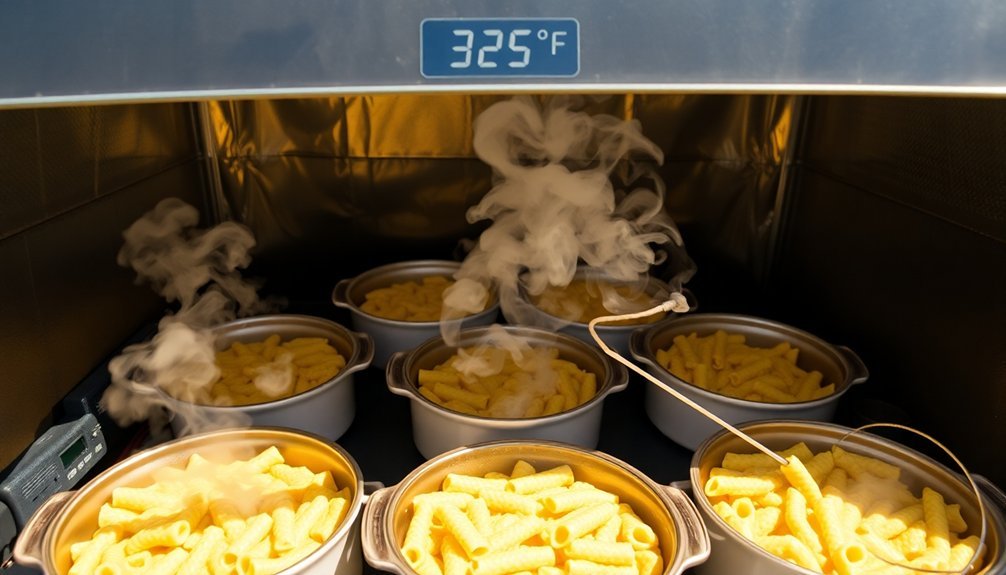
Maintaining consistent temperatures in a sun oven requires careful attention to positioning and monitoring. You'll need to track the sun's movement and adjust your oven every 30-45 minutes to keep temperatures stable between 150-225°F.
By choosing a sheltered spot and using dark-colored cookware with proper insulation, you can optimize heat retention throughout the cooking process.
For successful temperature management:
- Preheat your oven for 20-30 minutes before adding food
- Use a reliable thermometer to monitor cooking temperatures and a meat thermometer for protein doneness
- Add thermal mass materials like bricks or stones to help stabilize temperatures
Cook during peak sun hours (10 a.m. to 4 p.m.), and remember that cloudy conditions may double your cooking time.
Proper positioning and insulation will help maintain the steady temperatures needed for batch cooking.
Maximizing Solar Oven Space
To maximize space in your sun oven effectively, proper design and organization are essential for batch cooking success. Start by planning your oven's dimensions around your largest cooking vessel while ensuring there's enough room for insulation. You'll want to create an efficient layout that allows for multiple containers without blocking sunlight or reducing heat distribution.
| Space-Saving Tips | Benefits |
|---|---|
| Stack containers vertically | Doubles cooking capacity |
| Use dark, flat-bottomed pans | Improves heat absorption |
| Install adjustable racks | Enables flexible arrangements |
Consider using tiered cooking racks and strategically positioned reflective panels to direct sunlight to all cooking vessels. The interior's black coating and reflective surfaces should extend fully into corners, maximizing every inch of cooking space while maintaining ideal heat distribution throughout your batch cooking session.
Food Safety During Solar Cooking
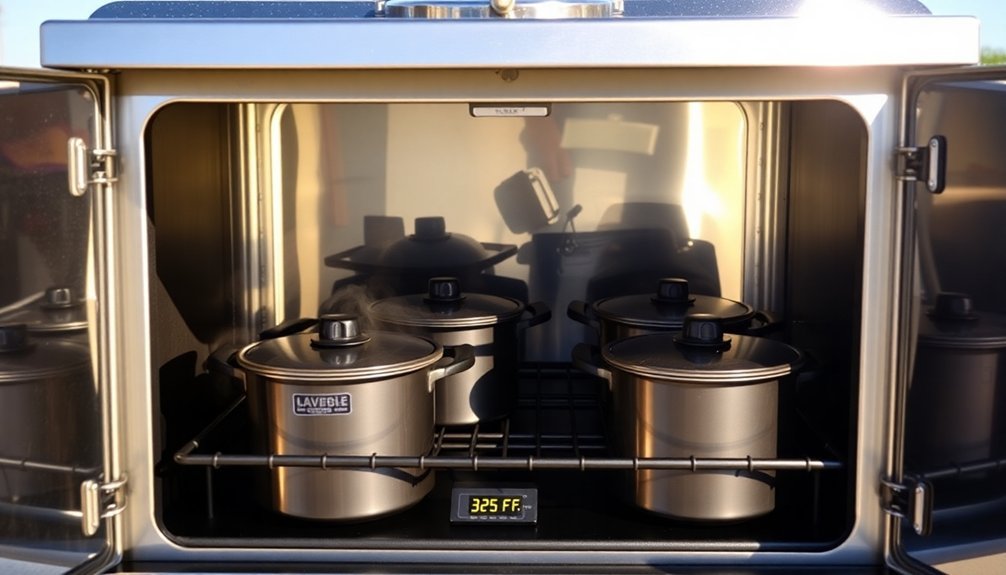
When you're cooking with the sun's power, proper food safety practices become essential to prevent foodborne illness.
You'll need to keep your sun oven preheated above 140°F and aim for cooking temperatures of at least 180°F to guarantee food safety. Monitor temperatures regularly with an oven thermometer and avoid leaving food in the danger zone between 50°F and 125°F.
For safe batch cooking in your sun oven, follow these critical steps:
- Position your oven to receive direct sunlight between 11 AM and 3 PM
- Don't leave cooked food in an unheated oven for more than 3-4 hours unless properly cooled
- Cool food quickly to below 50°F if you're not serving it immediately
Raw dried foods like grains and beans can safely wait in the oven before cooking starts, but monitor all food temperatures carefully throughout the process.
Frequently Asked Questions
Can Solar Ovens Be Used to Sterilize Medical Equipment?
Yes, you can sterilize medical equipment using solar ovens. They'll reach temperatures above 180°C on sunny days, meeting sterilization standards. You'll need direct sunlight and about an hour for effective sterilization.
How Do Solar Ovens Perform at High Altitudes Versus Sea Level?
You'll find solar ovens perform better at high altitudes due to less atmospheric interference and increased UV radiation. You can expect faster cooking times and higher temperatures compared to sea level operation.
What Happens if Animals Are Attracted to the Cooking Smells?
You'll need to protect your solar cooking by using covered containers, installing deterrents like fences or motion sensors, and keeping your cooking area clean. Don't leave food unattended to prevent animal interference.
Do Different Colored Cooking Vessels Affect the Taste of Food?
No, your pot's color won't affect food taste directly. However, dark-colored vessels retain moisture better and heat more efficiently, which helps preserve your food's natural flavors and nutrients during the cooking process.
Can Solar Ovens Be Used to Make Bread and Pastries?
Yes, you can bake bread and pastries in solar ovens. You'll need longer cooking times and temperatures between 200-300°F. While browning may not be as even, you'll still get fully cooked, soft results.
In Summary
You'll find success with batch cooking in your sun oven by combining the right timing, weather conditions, and food choices. Remember to monitor temperatures carefully, use appropriate cookware, and maximize your oven space for efficient cooking. With proper planning and attention to food safety, you can create multiple healthy meals using just the sun's power. Keep practicing, and you'll master this sustainable cooking method.

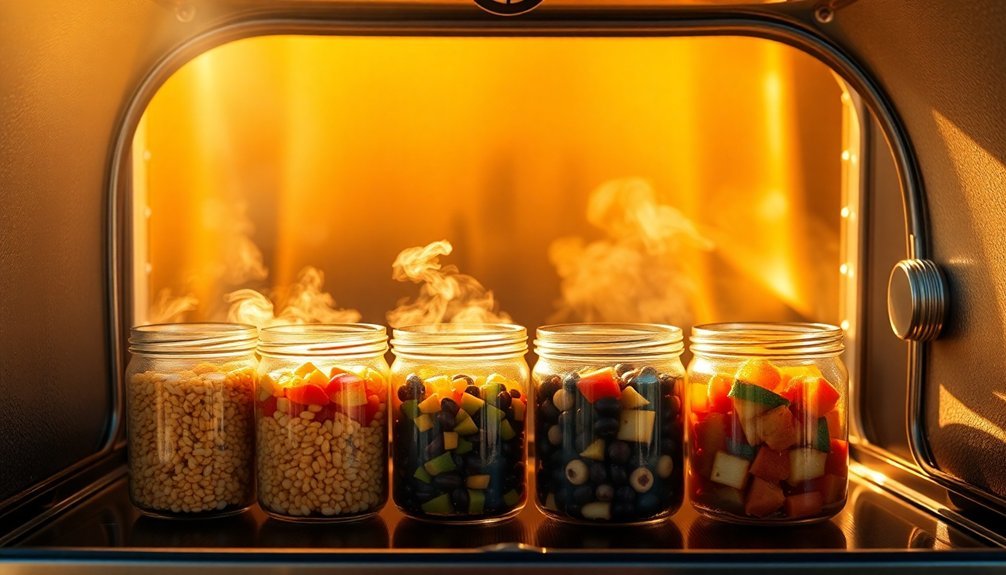



Leave a Reply